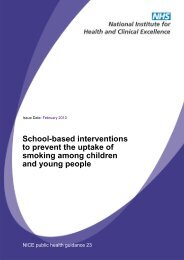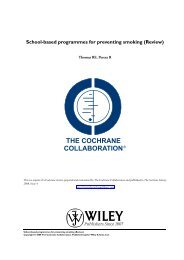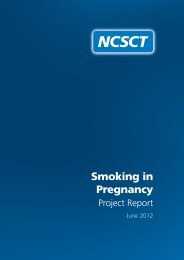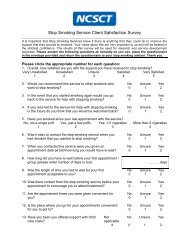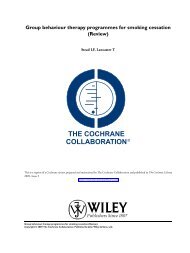Smoking and mental health - NCSCT
Smoking and mental health - NCSCT
Smoking and mental health - NCSCT
Create successful ePaper yourself
Turn your PDF publications into a flip-book with our unique Google optimized e-Paper software.
Neurobiological <strong>and</strong> behavioural mechanisms linking smoking <strong>and</strong> <strong>mental</strong> disorders 3<br />
Although it is clear that nicotine has the neurobiological <strong>and</strong> behavioural<br />
properties of a drug of dependence, when compared with many drugs of<br />
dependence used illicitly its reinforcing properties are weak <strong>and</strong> appear<br />
insufficient to account for the powerful dependence on tobacco experienced<br />
by most habitual smokers. 15 Furthermore, the therapeutic nicotine<br />
preparations commonly used to aid cessation are neither strongly effective in<br />
this regard nor commonly subject to abuse. These observations have led to the<br />
conclusion that the tobacco smoke vehicle, through which most people dose<br />
themselves with nicotine, may also play an important part in addiction to<br />
tobacco smoking.<br />
There are a number of components of tobacco smoke that could enhance the<br />
addictive properties of nicotine. Some of these inhibit the enzyme monoamine<br />
oxidase, which metabolises dopamine in the brain, thereby enhancing the<br />
rewarding effects evoked by release of this monoamine. 16–18 Studies in<br />
experi<strong>mental</strong> animals have confirmed that inhibition of monoamine oxidase<br />
potentiates nicotine self-administration. 19–21 Other studies have focused on the<br />
role of non-pharmacological factors such as environ<strong>mental</strong> or conditioned<br />
stimuli associated with the delivery of nicotine, both of which significantly<br />
enhance self-administration of nicotine. 22–24 Sensorimotor stimuli also seem to<br />
be important factors in the development of tobacco dependence, 25 particularly<br />
among highly dependent smokers. 26 These observations have led Rose 27 to<br />
suggest that non-nicotinic factors play a pivotal role in tobacco dependence.<br />
Similarly, these <strong>and</strong> other results have led Caggiula <strong>and</strong> colleagues 28 to propose a<br />
dual reinforcement model of tobacco dependence that relies on both the primary<br />
reinforcing properties of nicotine itself, <strong>and</strong> enhancement by nicotine of the<br />
reinforcing salience of other sensory or contextual stimuli, paired with the<br />
delivery of the drug.<br />
3.2 Models of association <strong>and</strong> sources of evidence<br />
One possible mechanism of association between smoking <strong>and</strong> <strong>mental</strong> disorders is<br />
the self-medication model, whereby smoking is used to alleviate symptoms,<br />
particularly those of negative affect <strong>and</strong> impaired cognition, 29,30 eg individuals<br />
with negative affect may turn to substance use, including tobacco, to alleviate<br />
emotional distress, 29 whereas individuals with attentional <strong>and</strong> learning deficits<br />
may use tobacco to help them overcome these limitations. Cultural <strong>and</strong> social<br />
beliefs, eg a belief that smoking is an effective anxiolytic or antidepressant, even<br />
in the absence of a true effect, may also contribute to this process. Alternatively,<br />
smoking could be a causal risk factor for the development of <strong>mental</strong> illness,<br />
although it is also possible that the association is due to confounding by other<br />
factors, eg genetic traits, that independently influence both smoking <strong>and</strong> <strong>mental</strong><br />
illness. In addition it is possible that the nature of the association changes with<br />
chronicity of exposure.<br />
© Royal College of Physicians 2013 39




